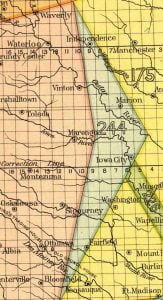
The history of the Sacs and Foxes of the Mississippi is the same as that of the Missouri portion of the tribes, except that they had never wandered so far from the ancestral home. They lived nearer the Mississippi River, and the other band lived on the Missouri Riveror the Osage, a branch of the Missouri, and from these circumstances came the names of the two bands. One band was the Sacs and Foxes of the Mississippi, and the other the Sacs and Foxes of the Missouri.
The Sacs and Foxes of the Mississippi owned and held about three-fourths of the State of Iowa up to the year 1842. On the 11th day of October of that year they ceded that magnificent domain to the United States. They were to be given another reservation upon the Missouri River, or some of the waters. They were given a tract of land thirty-four miles long by about twenty miles wide on the Marais des Cygnes west of the present town of Ottawa, Kansas. They did not arrive in Kansas until 1846. By January 1, of that year all the Sacs and one-fifth of the Foxes were on the Wakarusa. They were permitted to stop there by the Shawnees until the remainder of the Foxes could be present, when the reservation was to be selected. The missing Foxes were visiting the Pottawatomie. In the Spring those assembled on the Wakarusa selected the reservation, not wishing to wait longer. Those on the Wakarusa numbered something less than one thousand. They finally took up their residence about the point where Lyndon was later founded.
October 1, 1859, these Indians made a treaty by which all their lands lying west of the range-line of range sixteen, about three hundred thousand acres, were to be sold for their benefit. This left them about one hundred and fifty-three thousand acres. A strip of these trust lands six miles wide lay in Franklin County, Kansas, and was soon the prey of speculators, as they were called. One of these was John P. Usher, Secretary of the Interior in the Cabinet of President Lincoln, and who long lived at Lawrence, Kansas. These Indians were soon made the victims of a fraud. One Robert S. Stevens was in various very questionable schemes in Kansas in the early days. By some devious connection with the Indian Department he was employed to build for these Indians one hundred and fifty little stone houses on the lands remaining to them. They did not want these houses, and protested against the waste of their money for any such purpose. But their protests were unheeded at Washington. The grafters had the ear of the Government, as usual, and the Indians were robbed. This same Stevens worked the identical scheme on the Kansas Indians, on the Council Grove reservation. All these Indians, as soon as the little stone houses were completed, sold the doors, windows, and floors for whiskey, and stabled their ponies in the dilapidated ruins. They would not live in such houses.
The divestment of these Indians of the residue of their lands ran the usual course of fraud. The allotment plan was brought into play, and the cunningly devised chicanery wound their devious ways. They were given seven hundred and fifty square miles of land, supposed to be worthless, in what is now Oklahoma. In 1867 they began to migrate to that tract, and in a period of five years they were mostly living on it.
The Methodist Episcopal Church, South, did some missionary work among the Sacs and Foxes before the Civil War. In 1860 the Methodist Episcopal Church appointed Rev. Richard P. Duvall missionary to this tribe. He began his labors at the tribal agency at once. April, 1863, he opened the mission school. This was in two large buildings distant about a mile from the agency. In 1862-63 some of the tribe sent their children to Baker University, at Baldwin. No great progress was ever made in the work of Christianizing the Sacs and Foxes.
Discover more from Access Genealogy
Subscribe to get the latest posts sent to your email.
